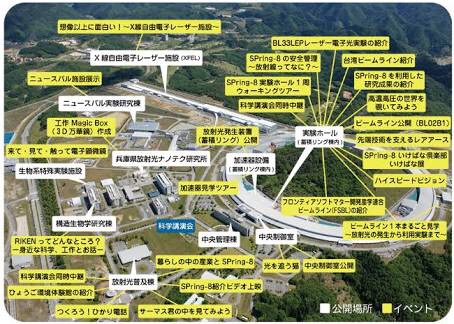
SPring-8: Clarification of major minerals in the Earth’s mantle: Synchrotron X-ray analysis
Germany: Bayern Geoscience Institute, Bayreuth University: Researcher Ishii, Professor Katsura,
Japan: Diffraction and Scattering Promotion Office, Research Center for High-Intensity Optical Science: Senior Researcher Tange and Higo
Univ of Bristol / Germany Synchrotron / Beijing High Voltage Science Research Center
Tohoku , Hiroshima , Okayama Univ
International Collaborative Research Team:
Using the synchrotron radiation X-ray from the large synchrotron radiation facility SPring-8, the main constituent minerals of the mantle were precisely determined.
Combines in-situ observation experiment under high temperature and high pressure (BL04B1) and thermochemical calculation.
The ‘decomposition reaction (post-spinel transition)’ from the main mineral ringwoodite of the upper mantle to the ‘bridgemanite and ferropericlase’ of the main constituent minerals of the lower mantle was precisely determined.
Conventional concept: Old theory
Traditionally, this ‘phase transition * 2’ has been thought to cause a ‘660 km discontinuity * 3’ that is the boundary between the upper and lower mantle of the earth.
This new discovery:
This time, we conducted the world’s most accurate high-temperature and high-pressure experiments and thermochemical calculations that were originally developed.
It turns out that the ‘pressure width of the post-spinel transition’ is an order of magnitude thinner than the ‘thickness detected by seismological observation’.
It was clarified that ‘660 km discontinuity * 3’ can be explained by this ‘phase transition * 2’.
Results of this research: Clarifying the dynamics of the Earth’s mantle
The theory that the Earth’s mantle is ‘pyrolite * 4 composition’ proved to be promising, suggesting a new method for detecting mantle convection.
By using this method, it is possible to clarify the dynamics of the Earth’s mantle, which was previously undetectable.
The results of this research were published on September 23 in Nature Geoscience, the world’s best geoscience journal.
-TOHOKU UNIVERSITY-
https://www.tohoku.ac.jp/japanese/2019/10/press20191004-01-SPring.html